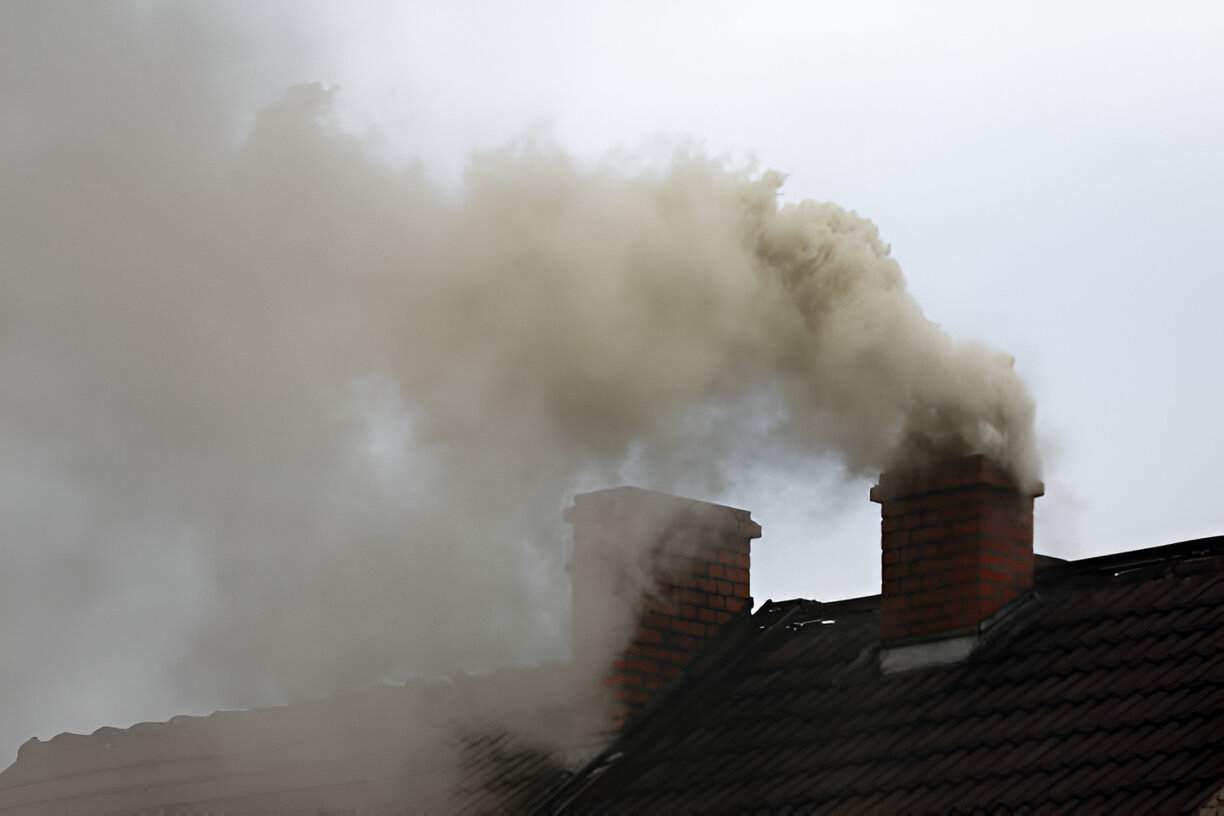Key Takeaways
- Smoke entering your home typically signals a chimney draft issue.
- Causes include cold flues, creosote blockages, poor ventilation, negative pressure, or improper chimney height.
- Simple fixes, such as preheating the flue or opening a nearby window, may help temporarily.
- For persistent issues, professional chimney inspection and repair may be required.
- Firesafe Chimney Services offers expert solutions for smoke and draft problems.

There are few things more frustrating than lighting your fireplace on a cold day only to have smoke pour back into your living room. This common issue is often caused by problems with your chimney's draft system. Understanding why your chimney isn't drawing properly and what steps you can take to correct the issue are key to restoring safe, smoke-free operation.
At Firesafe Chimney Services, we help homeowners address these challenges every heating season. Whether it’s a cold flue, obstructed liner, or negative air pressure, this guide will walk you through common causes, how to troubleshoot, and when to call a professional for help.
6 Reasons Your Fireplace Fills the House with Smoke
1. Cold Chimney Flue
One of the most common causes of smoke entering your home is a cold chimney flue. When the chimney isn’t preheated, cold air sitting inside creates a wall that prevents smoke from rising. Instead of drawing upward, the smoke pushes back into your home.
Solution: Preheat the flue by holding a rolled newspaper or a firestarter near the damper for a minute or two before starting your fire. This warms up the air column and helps establish an upward draft.
2. Blockages or Creosote Buildup
Soot, creosote, animal nests, and even fallen masonry can obstruct the flue. These blockages restrict airflow and prevent smoke from exiting efficiently. In extreme cases, they can also present a fire hazard.
Solution: Schedule a professional chimney cleaning service to remove any buildup or obstructions.
3. Negative Air Pressure
Modern homes are often sealed tightly for energy efficiency. Unfortunately, this can lead to a vacuum effect where the home draws air in through the chimney, reversing the flow of smoke.
Solution: Try cracking open a window in the same room as the fireplace to allow fresh air to enter and balance internal pressure. This simple fix can significantly improve draft performance.
4. Improper Chimney Height or Design
If your chimney is too short, too narrow, or located in an area with nearby obstructions like trees or taller structures, it may not develop a proper draft. Short chimneys especially have trouble maintaining consistent upward airflow.
Solution: A certified chimney inspection can evaluate whether your chimney height and design meet current building code standards.
5. Wind-Induced Downdrafts
Certain wind patterns, especially in hilly or densely built areas, can force air down the chimney flue. This effect is especially strong in uncapped chimneys or those with poorly designed caps.
Solution: Installing a chimney cap can help deflect wind and prevent downdrafts.
6. Damaged or Stuck Damper
If your damper doesn’t open fully or is obstructed by creosote, rust, or debris, it can restrict smoke from escaping.
Solution: Ensure the damper is fully open before lighting a fire. If the damper is damaged or stuck, it may need to be repaired or replaced.
Troubleshooting Chimney Draft Problems
- Open the Damper: Confirm it’s fully open before every use.
- Preheat the Flue: Light newspaper and hold it near the damper to create an upward draft.
- Improve Ventilation: Open a window slightly in the same room.
- Use Proper Firewood: Only burn seasoned hardwood. Wet or green wood creates excessive smoke.
- Inspect for Obstructions: If you feel confident, use a flashlight to check for visible blockages. Otherwise, schedule a professional inspection.
If you’ve tried these steps and still experience issues, the problem may be structural or require specialized equipment to diagnose.
How to Identify and Fix Common Smoke Draw Issues
Not all draft issues are easily resolved with a DIY approach. Here are some fixes that may require professional intervention:
- Chimney Sweeping: Removing creosote and blockages improves airflow.
- Chimney Cap Installation: Prevents wind-induced downdrafts.
- Flue Liner Repairs: Cracks or deterioration in the liner can impact draft performance.
- Chimney Height Modifications: Ensures the flue meets minimum height standards.
- Airflow Assessments: Pressure tests can determine if your home needs additional ventilation.
Our team is trained to identify these issues and provide permanent solutions. Visit our chimney repair page for more information.
Conclusion
Smoke pouring into your living space is not only unpleasant but also dangerous. Understanding how your chimney draft works and recognizing the warning signs of poor airflow can help you take the right action.
While some fixes are simple, others require a professional touch. Don’t risk poor indoor air quality or fire hazards. Firesafe Chimney Services is here to diagnose and resolve chimney draft problems for homeowners with prompt, professional care.
Why Choose Firesafe Chimney Services
We are Worcester’s trusted chimney experts in chimney troubleshooting, repair, and draft correction. With years of local experience, our team understands the unique challenges that New England homes face due to weather, age, and construction style.
Contact us today to schedule an evaluation.
Frequently Asked Questions
Q1.Why is smoke entering my home when I use the fireplace?
A: It’s typically due to poor chimney draft caused by cold flue air, blockages, negative air pressure, or a stuck damper.
Q2.Can I fix smoke problems myself?
A:Some simple fixes like preheating the flue or opening a window can help. However, persistent problems usually require professional inspection.
Q3.Do I need a chimney cap to stop smoke?
A: chimney cap can help prevent wind downdrafts that force smoke back into the home. It also keeps debris and animals out of your flue.
Q4.Is chimney smoke dangerous?
A:Yes. Inhalation of smoke and carbon monoxide can be hazardous. If your chimney isn’t drafting properly, discontinue use and call a professional.












